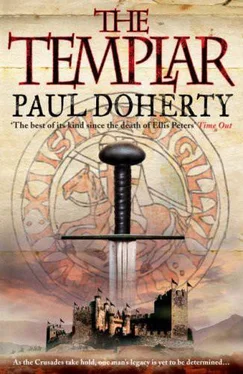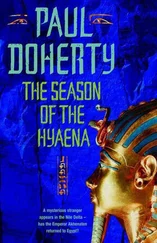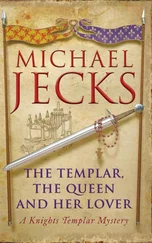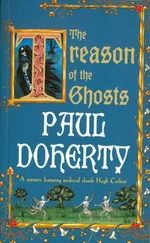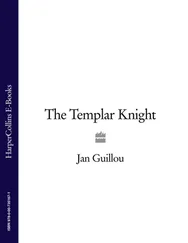P. Doherty - The Templar
Здесь есть возможность читать онлайн «P. Doherty - The Templar» весь текст электронной книги совершенно бесплатно (целиком полную версию без сокращений). В некоторых случаях можно слушать аудио, скачать через торрент в формате fb2 и присутствует краткое содержание. Год выпуска: 2010, ISBN: 2010, Издательство: Minotaur Books, Жанр: Исторические приключения, на английском языке. Описание произведения, (предисловие) а так же отзывы посетителей доступны на портале библиотеки ЛибКат.
- Название:The Templar
- Автор:
- Издательство:Minotaur Books
- Жанр:
- Год:2010
- ISBN:9780312576837
- Рейтинг книги:5 / 5. Голосов: 1
-
Избранное:Добавить в избранное
- Отзывы:
-
Ваша оценка:
- 100
- 1
- 2
- 3
- 4
- 5
The Templar: краткое содержание, описание и аннотация
Предлагаем к чтению аннотацию, описание, краткое содержание или предисловие (зависит от того, что написал сам автор книги «The Templar»). Если вы не нашли необходимую информацию о книге — напишите в комментариях, мы постараемся отыскать её.
The Templar — читать онлайн бесплатно полную книгу (весь текст) целиком
Ниже представлен текст книги, разбитый по страницам. Система сохранения места последней прочитанной страницы, позволяет с удобством читать онлайн бесплатно книгу «The Templar», без необходимости каждый раз заново искать на чём Вы остановились. Поставьте закладку, и сможете в любой момент перейти на страницу, на которой закончили чтение.
Интервал:
Закладка:
‘Relics?’ Eleanor queried.
‘They are in great demand,’ Theodore explained, ‘by both the angels and the demons, which is,’ he drummed his thickset fingers against his wine goblet, ‘why I am here, along with your brother, Godefroi, Alberic and Norbert.’
Eleanor stared at the lancet window. The piece of stretched linen had been removed to let in the light. She quickly recalled the stories about various churches and their hunger for relics.
‘Pieces of bone,’ she murmured. ‘Shards of cloth, dried flesh, flakes of skin.’
‘True,’ Hugh replied, ‘but listen, Eleanor! Norbert has travelled to Outremer. He has been to Constantinople and visited Jerusalem.’
‘As did Anstritha.’
‘So I understand, but let me explain. Norbert was expelled from his monastery because of his mockery of certain relics held by his community. He was not stripped of his orders, just given licence to leave. At first he considered preaching against the veneration of what you call pieces of bone and shards of cloth; then he met Alberic and they both came to Constantinople.’
‘What!’ Eleanor exclaimed.
‘Alberic left his parish church for this Crusade. He claims he is in the thirtieth year of penance for the betrayal of his master. He was born of noble Saxon family and became a member of the housecarls, the personal bodyguard of Harold Godwinson the Saxon king defeated by William the Norman at the battle of Senlac thirty years ago. Alberic has described, how, in the final moments of the battle, as the sun set that October day, the Saxon line finally buckled. He believes he should have stayed and died beside his master. Instead he fled. For a while he sheltered in the wild wastes and the great forest that border the southern coast of England. He became a hermit, torn by guilt, a desire to make reparation, to seek forgiveness for what he still regards as a betrayal. For a while he called himself Judas. Eventually he found that even living in his own country, however reclusive he remained, only deepened the wound. So he took ship to France and wandered the roads. He eventually met Norbert, who recognised him as an educated man. After a prolonged stay at Soissons, Norbert arranged for Alberic to be ordained…’
‘Do Alberic and Norbert know you are telling me this?’
‘Of course,’ Hugh smiled. ‘Norbert asked you to speak to Fulcher; he later heard that man’s confession.’
‘And would you ever have spoken?’ Eleanor accused.
‘Yes,’ Hugh insisted, ‘but as I shall explain, there is also great danger in all of this. Anyway, Alberic and Norbert took to wandering. They witnessed all forms of cruelty and began to doubt the truth of religion, any idea of a loving God or the Incarnation of the Christ.’ Hugh sipped at his wine. ‘Little wonder,’ he added. ‘I have been down the same path myself. At last they visited Jerusalem, where they sheltered for two years next to the Holy Sepulchre.’
‘They were not persecuted?’
‘Contrary to belief,’ Theodore spoke up, ‘the Turks regard Christ as a great prophet. The real persecution took place under the mad caliph Al-Hakim, who treated his own subjects as barbarously as he did others before going completely mad and declaring himself God. No, Alberic and Norbert were left alone. During their stay they heard rumours about great treasures in Jerusalem, relics of the Passion that would prove not only that Christ died but that he rose from the dead. I, too, have heard similar stories.’
‘According to Alberic and Norbert,’ Hugh continued, ‘who have studied manuscripts such as the Life of St Nino, beneath the Dome of the Rock where Solomon’s Temple once stood are sealed chambers that used to house the stables of the great Jewish king. In there lie marvellous relics closely associated with the Passion and Resurrection of the Lord. The two of them faithfully collected these stories, and it rekindled their faith. As Norbert remarked, what use debating about logic or philosophy? Instead they recalled the words of St Paul: “If Christ has not risen, then all that we do is in vain.” They concentrated on this: whatever cruelty ravished the earth, whatever terror stalked, if the Lord Christ came out from His tomb glorified and resurrected, then there were hidden, greater truths. Think, Eleanor! If someone arrived here now and could prove that Jesus of Nazareth remained a corpse, what use is there in us being here? What use the Mass, the Eucharist, the Sacraments, the Gospels? We’d all go home. However, if Christ did rise from the dead, leaving all other questions aside, that is our faith. If such relics exist, the Holy Sepulchre must be liberated. It must become the centre of the Church, and if beneath the Dome of the Rock lie true relics, evidence for Christ’s Passion and Resurrection, then…’ Hugh held his hands up, ‘why shouldn’t we go to Jerusalem?’
‘And who is party to this?’
‘Everyone here, as well as Alberic and Norbert, whom we trust.’
‘And Anstritha?’ Eleanor opened the wallet on her belt and brought out the piece of parchment Fulcher had entrusted to her. She opened this up and pushed it across to Hugh: he seized it, studied it and passed it round the others.
‘Further proof,’ he murmured. ‘I do not know what Anstritha found. Norbert and Alberic only told me after she was killed how she too had searched for certain relics. Alberic hid when she came to seek sanctuary in his church; he was terrified she might name him as an accomplice.’ Hugh drew a deep breath. ‘Anstritha was the widow of a physician. She journeyed to Jerusalem where she met Alberic and Norbert. They became members of the Temple Brotherhood, a secret community dedicated to discovering relics of the Lord’s Passion. Anstritha never mentioned any half-brother, hidden menaces or secret enemies, but she did collect information about the Dome of the Rock, hence this map. Alberic later persuaded her to return to France, where she settled at St Nectaire. When the Crusade was preached, Norbert, recalling my family’s links with the Benedictine order, journeyed to ask for my help.’ Hugh leaned forward, face excited. ‘When Jerusalem falls, we shall seek out these treasures of God. Look upon the face of Christ, reveal them to the rest of Christendom! Proof that Our Lord lived, died and was resurrected, leaving sacred marks on certain cloths.’
‘And Veronica?’ Eleanor asked. ‘Fulcher gave me that name.’
‘The woman who cleansed Christ’s face as he was being led out to crucifixion. According to some legends, Veronica also provided the mandylion, which covered the divine face in the sepulchre, as well as the shroud in which His body was wrapped. Legend has it that a woman should keep these sacred cloths and be given the title “Veronica”. Those icons you viewed in Hagia Sophia? You noticed the similarity in different paintings from different eras? My belief, as well as that of the Poor Brethren, is that they are all based on the real image of Our Saviour, which has now disappeared, though we shall find it.’ Hugh paused as Eleanor raised a hand.
‘You mentioned the Resurrection? This is more than a holy relic? The relics we studied in Hagia Sophia, they are all based on the real likeness of Christ?’
‘A miraculous likeness,’ Hugh replied. ‘Transferred to cloth by divine means. Proof that Christ did suffer but rose again. These relics are not just ordinary ones, but living proof of our belief.’
‘And Norbert and Alberic have discovered evidence for this?’
‘Norbert was allowed into many monasteries to study in their scriptoria and libraries and trace the history of these holy Images. About a hundred years ago a group of refugee Greek monks set up a cult in Rome near the abandoned church of St Boniface. They worshipped an icon that one manuscript describes as an image of Our Lord Jesus, not fashioned by human hand, imprinted on a shroud. According to another document, the Acts of Thaddeus, Jesus wiped his face on a cloth folded in four yet left his image on it. More importantly, Pope Stephen II delivered a sermon, oh, some three hundred years ago, in which he described a famous cloth.’ Hugh closed his eyes as he recalled the lines. ‘ “Wonderful it is to see or hear such a thing, the glorious face of Jesus, and the majestic form of his whole body has been miraculously transferred. For those who never had the opportunity to see his earthly appearance, they can do so as it has been imprinted on the linen.” ’ He opened his eyes. ‘Don’t you see, Eleanor — an image of Christ as he really was?’
Читать дальшеИнтервал:
Закладка:
Похожие книги на «The Templar»
Представляем Вашему вниманию похожие книги на «The Templar» списком для выбора. Мы отобрали схожую по названию и смыслу литературу в надежде предоставить читателям больше вариантов отыскать новые, интересные, ещё непрочитанные произведения.
Обсуждение, отзывы о книге «The Templar» и просто собственные мнения читателей. Оставьте ваши комментарии, напишите, что Вы думаете о произведении, его смысле или главных героях. Укажите что конкретно понравилось, а что нет, и почему Вы так считаете.
